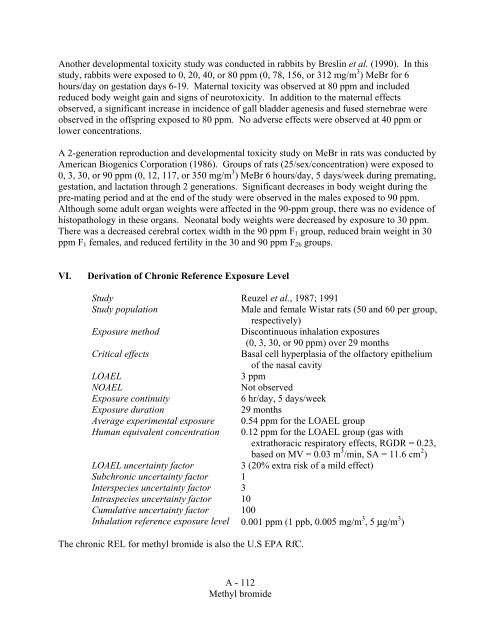METHYL BROMIDE - OEHHA
METHYL BROMIDE - OEHHA
METHYL BROMIDE - OEHHA
Create successful ePaper yourself
Turn your PDF publications into a flip-book with our unique Google optimized e-Paper software.
Another developmental toxicity study was conducted in rabbits by Breslin et al. (1990). In this<br />
study, rabbits were exposed to 0, 20, 40, or 80 ppm (0, 78, 156, or 312 mg/m 3 ) MeBr for 6<br />
hours/day on gestation days 6-19. Maternal toxicity was observed at 80 ppm and included<br />
reduced body weight gain and signs of neurotoxicity. In addition to the maternal effects<br />
observed, a significant increase in incidence of gall bladder agenesis and fused sternebrae were<br />
observed in the offspring exposed to 80 ppm. No adverse effects were observed at 40 ppm or<br />
lower concentrations.<br />
A 2-generation reproduction and developmental toxicity study on MeBr in rats was conducted by<br />
American Biogenics Corporation (1986). Groups of rats (25/sex/concentration) were exposed to<br />
0, 3, 30, or 90 ppm (0, 12, 117, or 350 mg/m 3 ) MeBr 6 hours/day, 5 days/week during premating,<br />
gestation, and lactation through 2 generations. Significant decreases in body weight during the<br />
pre-mating period and at the end of the study were observed in the males exposed to 90 ppm.<br />
Although some adult organ weights were affected in the 90-ppm group, there was no evidence of<br />
histopathology in these organs. Neonatal body weights were decreased by exposure to 30 ppm.<br />
There was a decreased cerebral cortex width in the 90 ppm F1 group, reduced brain weight in 30<br />
ppm F1 females, and reduced fertility in the 30 and 90 ppm F2b groups.<br />
VI. Derivation of Chronic Reference Exposure Level<br />
Study Reuzel et al., 1987; 1991<br />
Study population Male and female Wistar rats (50 and 60 per group,<br />
respectively)<br />
Exposure method Discontinuous inhalation exposures<br />
(0, 3, 30, or 90 ppm) over 29 months<br />
Critical effects Basal cell hyperplasia of the olfactory epithelium<br />
of the nasal cavity<br />
LOAEL 3 ppm<br />
NOAEL Not observed<br />
Exposure continuity 6 hr/day, 5 days/week<br />
Exposure duration 29 months<br />
Average experimental exposure 0.54 ppm for the LOAEL group<br />
Human equivalent concentration 0.12 ppm for the LOAEL group (gas with<br />
extrathoracic respiratory effects, RGDR = 0.23,<br />
based on MV = 0.03 m 3 /min, SA = 11.6 cm 2 )<br />
LOAEL uncertainty factor 3 (20% extra risk of a mild effect)<br />
Subchronic uncertainty factor 1<br />
Interspecies uncertainty factor 3<br />
Intraspecies uncertainty factor 10<br />
Cumulative uncertainty factor 100<br />
Inhalation reference exposure level 0.001 ppm (1 ppb, 0.005 mg/m 3 , 5 μg/m 3 )<br />
The chronic REL for methyl bromide is also the U.S EPA RfC.<br />
A - 112<br />
Methyl bromide















